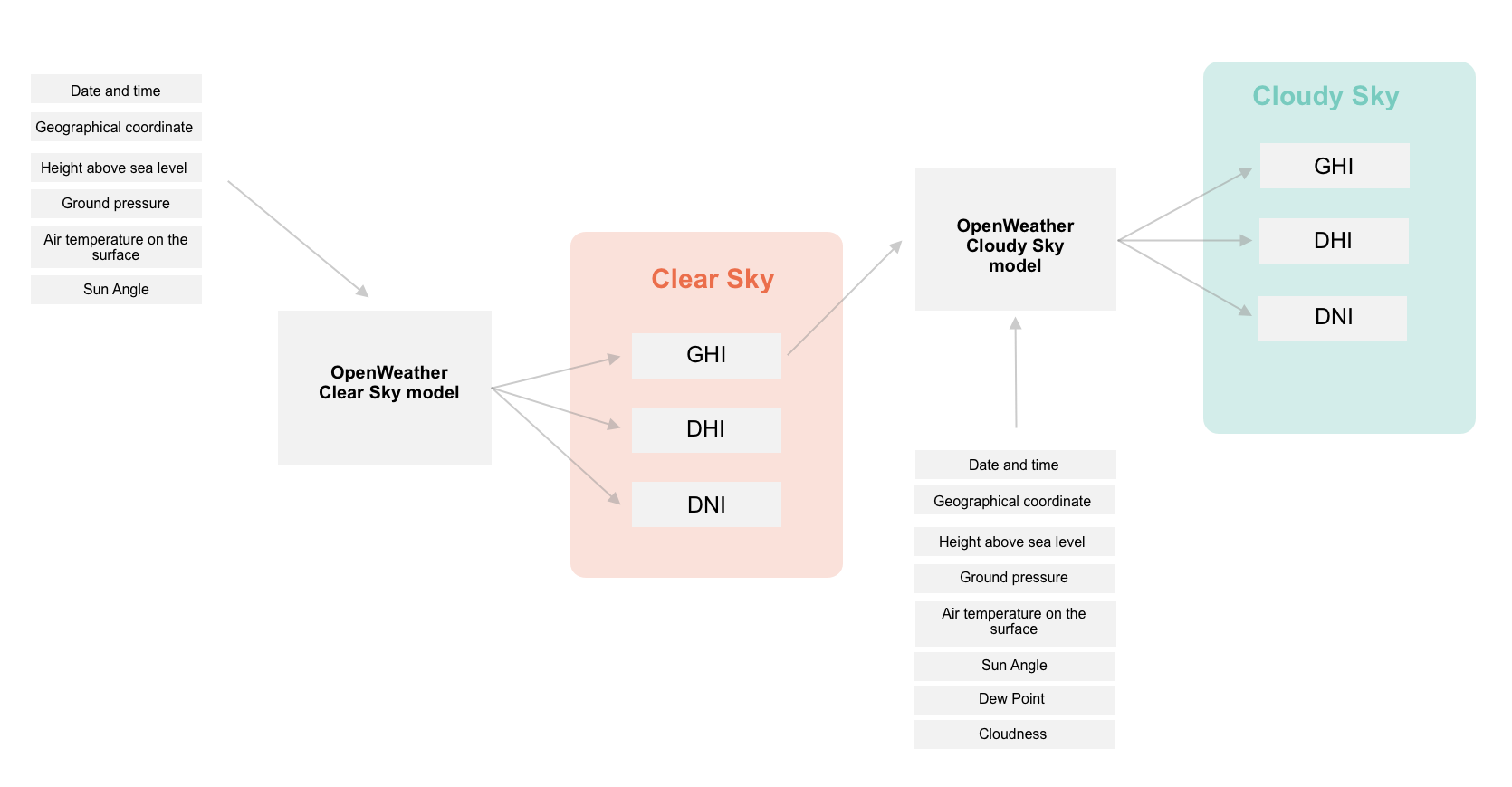Solar Irradiance technology
Introduction
Considering the importance of ecology and the search for renewable energy sources in the modern world, our company has decided to make a contribution to this cause. We wanted to give all our users an opportunity to get valuable data easily, regardless of the size of their projects.
Although Solar Irradiance & Energy Prediction service was created on the basis of a large number of scientific articles, algorithms, models and data sources, we wanted, as always, to ensure that our final product is as versatile and easy to use as possible.
The basic definitions of solar power sector are solar irradiation and solar irradiance and are often used interchangeably. However, they are not a synonyms:
- Solar irradiation is the total energy received by a surface of the Earth per unit area over a given period of time. It is the amount of radiation (also known as shortwave radiation) passing through a horizontal plane. Solar irradiance is measured in Wh/m2.
- Solar irradiance is the surface power density received by a surface of the Earth. Solar irradiance is measured in W/m2.
To convert irradiance to irradiation please use the formula below:
Energy(Wh/m2) = Power(W/m2) * TimeInterval(h)
where energy is a solar irradiation; power is a solar irradiance.
For energy data values for 1 h period of TimeInterval = 1
For energy data values for 15 min period of TimeInterval = 0.25
At the first stage of product development, we have selected the most common indices for solar irradiation measurements: DNI, DHI and GHI. We provide each of them for the Clear Sky and Cloudy Sky models:
- Direct Normal Irradiation (DNI) is the amount of solar irradiation received per unit area by a surface that is always held perpendicular (or normal) to the rays that come in a straight line from the sun at its current position in the sky. Typically, you can maximise the amount of irradiation that a surface receives annually by keeping it normal to incoming irradiation. This quantity is of particular interest to concentrating solar thermal installations and installations that track the position of the sun.
- Diffuse Horizontal Irradiation (DHI) is the amount of irradiation received per unit area by a surface (not subject to any shade or shadow) that does not arrive on a direct path from the sun, but has been scattered by molecules and particles in the atmosphere and comes equally from all directions.
- Global Horizontal Irradiation (GHI) is the total amount of short-wave radiation received from above by a surface horizontal to the ground. This value is of particular interest to photovoltaic installations, and includes both DNI and DHI.
To calculate these indices, we use the most accurate algorithms available, such as Simplified Solis for Clear Sky and DirInt for Cloudy Sky.
Nevertheless, when we employed these algorithms in their original form, we obtained results of unsatisfactory accuracy (here are the materials that we used as reference data). So that we could deliver a great product, we did a lot of additional work on further refining the algorithms to get more accurate output. Below are descriptions of the data in the OpenWeather algorithms.
OpenWeather Clear Sky model
Based on the Simplified Solis algorithm, we have developed our own algorithm called the OpenWeather Clear Sky model. In comparison with the standard input data for the Simplified Solis algorithm, we have enriched the set of input data to our algorithm.
As a result, the following input data is used in the OpenWeather Clear Sky model:
- Date and time
- Geographical coordinates
- Sunrise and sunset times
- Height above sea level
- Ground pressure
- Air temperature on the surface
- Solar zenith angle.
Here are our proprietary improvements to the original algorithm.
We send date and time data to the algorithm with a shift of half of a time cycle. According to the 1-hour step of solar radiation forecast data, we shift the date and time half an hour backward for hourly data. This was implemented in order to better consider the position of the sun. When we use the data for the middle of an hour, the model works with values of sun position that are close to the average value of the period, which gives a more accurate result than the values at the beginning or end of the period.
Besides this, we correct the calculation of the sun angles, and transfer them to the OpenWeather Clear Sky algorithm by using the sunrise and sunset times within the algorithm. This is needed in order to minimise the anomalous values of the calculated radiation when the altitude angle of the sun approaches 0 degrees during sunrise and sunset (when the angle approaches these values, the radiation values do not increase adequately, becoming unrealistic).
Based on the results of the OpenWeather Clear Sky algorithm, we obtain three parameters: DNI Clear Sky, DHI Clear Sky and GHI Clear Sky.
The Simplified Solis algorithm description, which is part of the ‘pvlib’ library, can be found here.
OpenWeather Cloudy Sky model
We have also developed the OpenWeather Cloudy Sky model for the calculation of cloudy sky solar radiation data, by improving and correcting the DirInt algorithm. For instance, we have derived the formula for cloudiness correction, which is one of the most important elements of calculating cloudy sky solar radiation data.
Basically, all OpenWeather products provide the cloudiness data as a percentage, but our correction is allowed to get the new cloudiness correction coefficient. It means that we convert the percentage values (which show how cloudy the area is) to the exact coefficient of cloud transmittance (which can be multiplied by the radiation value to get its real value).
For example, if we have a high percentage of cloudiness, this means that the radiation in this place will be weak due to the clouds. As the next step, we calculate the correction factor of cloudiness to get cloud transmittance. After that, we multiply the radiation value by this coefficient and get the final version for solar radiation.
If we have no clouds, which means the radiation will be strong, the cloudiness correction coefficient has no effect on the solar radiation level.
Finally, we have the following input data for OpenWeather Cloudy Sky:
- GHI index from OpenWeather Clear Sky model results
- Dew point
- Cloudiness
- Date and time
- Geographical coordinates
- Height above sea level
- Ground pressure
- Air temperature on the surface
- Solar zenith angle.
As before, most of the input data is taken from the OpenWeather datasets and products. As a result of the OpenWeather Cloudy Sky algorithm, we have three parameters: DNI Cloudy Sky, DHI Cloudy Sky and GHI Cloudy Sky.
The DirInt algorithm description can be found here.

Reference data for solar radiation model experiments
We conducted training and corrected our models by using reference data. As a result, we managed to achieve a sufficiently high accuracy from the product. As reference data, we used data from the ECMWF meteorological agency and the Copernicus programme (the European Union’s Earth Observation Programme). Thus we not only took data from weather models but also measured historical data from sensors. We used ERA5 as a weather model source and the CAMS programme data as a sensor’s real data. The ERA5 model has a resolution of 0.36 degrees and contains only historical data with a one-week delay. You can learn more about ERA5 here.
More information on data from the CAMS programme can be found here.
Most of the input data to the OpenWeather Cloudy Sky and Clear Sky models is taken from the OpenWeather datasets and products.
Please let us know if you have any questions about the Solar Irradiance API, and our technical support team will be happy to help you.









